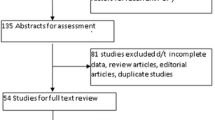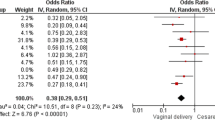Abstract
Female pelvic organ prolapse is a common condition that is said to be multifactorial in aetiology. While a number of risk factors such as vaginal childbirth, obesity and ageing are commonly accepted, it is not clear as to how these risk factors affect the development of prolapse—that is, which pathophysiologic mechanisms are responsible for disease manifestation. Measures used in epidemiological studies, such as presentation for surgical treatment, are generally confounded by other conditions, and evidence is lacking for some of the most frequently quoted aetiological factors. In this paper, I will try to summarise the available evidence in order to separate hearsay and hypothesis from available research findings and to suggest a way forward for diagnosis and treatment.


Similar content being viewed by others
References
DeLancey J (2005) The hidden epidemic of pelvic floor dysfunction: achievable goals for improved prevention and treatment. Am J Obstet Gynecol 192:1488–1495
Boyles S, Weber A, Meyn LA (2003) Procedures for pelvic organ prolapse in the United States, 1979–1997. Am J Obstet Gynecol 188:108–115
Subak LL, Waetjen LE, Van den ES, Thom DH, Vittinghoff E, Brown JS (2001) Cost of pelvic organ prolapse surgery in the United States. Obstet Gynecol 98:646–651
Dietz HP, Haylen BT, Vancaillie TG (2002) Female pelvic organ prolapse and voiding function. Int Urogynecol J 13:284–288
Dietz HP, Korda A (2005) Which bowel symptoms are most strongly associated with a true rectocele? Aust N Z J Obstet Gynaecol 45:505–508
Mant J, Painter R, Vessey M (1997) Epidemiology of genital prolapse: observations from the Oxford Family Planning Association Study. Br J Obstet Gynaecol 104:579–585
Patel D, Xu X, Thomason A, Ransom S, Ivy J, DeLancey J (2006) Childbirth and pelvic floor dysfunction: an epidemiologic approach to the assessment of prevention opportunities at delivery. Am J Obstet Gynecol 195:23–28
Hendrix S, Clark A, Nygaard I, Aragaki A, Barnabei V, McTiernan A (2002) Pelvic organ prolapse in the women's health initiative: gravity and gravidity. Am J Obstet Gynecol 186:1160–1166
Swift S, Woodman P, O'Boyle A et al (2005) Pelvic organ support study (POSST): the distribution, clinical definition, and epidemiologic condition of pelvic organ support defects. Am J Obstet Gynecol 192:795–806
Anonymous (2000) Risk factors for genital prolapse in non-hysterectomized women around menopause. Results from a large cross-sectional study in menopausal clinics in Italy. Progetto Menopausa Italia Study Group. Eur J Obstet Gynecol Reprod Biol 93:135–140
Lukacz ES, Lawrence J, Contreras R, Nager C, Luber KM (2006) Parity, mode of delivery, and pelvic floor disorders. Obstet Gynecol 107:1253–1260
Richardson AC, Lyon JB, Williams NL (1976) A new look at pelvic relaxation. Am J Obstet Gynecol 126:568–573
Lubowski DZ, Swash M, Nicholls RJ, Henry MM (1988) Increase in pudendal nerve terminal motor latency with defaecation straining. Br J Surg 75:1095–1097
Lien K, Morgan D, DeLancey J, Ashton Miller JA (2005) Pudendal nerve stretch during vaginal birth: a 3D computer simulation. Am J Obstet Gynecol 192:1669–1676
Handa VL, Pannu HK, Siddique S, Gutman R, VanRooyen J, Cundiff GW (2003) Architectural differences in the bony pelvis of women with and without pelvic floor disorders. Obstet Gynecol 102:1283–1290
Lind LR, Lucente V, Kohn N (1996) Thoracic kyphosis and the prevalence of advanced uterine prolapse. Obstet Gynecol 87:605–609
Jelovsek J, Maher C, Barber MD (2007) Pelvic organ prolapse. Lancet 369:1027–1038
Rinne KM, Kirkinen PP (1999) What predisposes young women to genital prolapse? Eur J Obstet Gynecol Reprod Biol 84:23–25
Spence-Jones C, Kamm MA, Henry MM, Hudson CN (1994) Bowel dysfunction: a pathogenic factor in uterovaginal prolapse and urinary stress incontinence. Br J Obstet Gynaecol 101:147–152
Zacharin R (1977) A Chinese anatomy—the pelvic supporting tissues of the Chinese and Occidental female compared and contrasted. Aust N Z J Obstet Gynaecol 17:1–11
Laborda E, Gelman W, Anthony F, Monga A (2003) Is increased collagen metabolism the cause or effect of prolapse?—a controlled study. Neurourol Urodyn 22:505–506
Phillips CH, Anthony F, Benyon C, Monga AK (2006) Collagen metabolism in the uterosacral ligaments and vaginal skin of women with uterine prolapse. Br J Obstet Gynaecol 113:39–46
Dietz H, Eldridge A, Grace M, Clarke B (2004) Pelvic organ descent in young nulliparous women. Am J Obstet Gynecol 191:95–99
Swift SE (2000) The distribution of pelvic organ support in a population of female subjects seen for routine gynecologic health care. Am J Obstet Gynecol 183:277–285
Goh J (2002) Biomechanical properties of prolapsed vaginal tissue in pre- and postmenopausal women. Int Urogynecol J 13:76–79
Baessler K, O'Neill S, Battistutta D, Maher C (2006) Prevalence, incidence, progression and regression and associated symptoms of pelvic organ prolapse. Int Urogynecol J 17:S70
Lawrence J, Lukacz ES, Nager CW, Hsu J-WY, Luber KM (2008) Prevalence and co-occurrence of pelvic floor disorders in community-dwelling women. Obstet Gynecol 111:678–685
Rizk D, Fahim M (2008) Ageing of the female pelvic floor: towards treatment ‘a la carte’ of the ‘geripause’. Int Urogynecol J 19:455–458
Weemhoff M, Shek KL, Dietz HP (2008). Effects of age on levator morphometry and function. Neurourol Urodyn (in press)
Trowbridge ER, Wei JT, Fenner DE, Ashton-Miller J, DeLancey J (2007) Effects of ageing on lower urinary tract and pelvic floor function in nulliparous women. Obstet Gynecol 109:715–720
Demirci F, Yucel O, Eren S, Alkan A, Demirci E, Yildirim U (2001) Long-term results of Burch colposuspension. Gynecol Obstet Invest 51:243–247
Dietz HP, Wilson PD (2000) Colposuspension success and failure: a long-term objective follow-up study. Int Urogynecol J 11:346–351
Daellenbach P, Kaelin-Gambirasio I, Dubuisson J, Boulvain M (2007) Risk factors for pelvic organ prolapse repair after hysterectomy. Obstet Gynecol 110:625–632
Olsen AL, Smith VJ, Bergstrom JO, Colling JC, Clark AL (1997) Epidemiology of surgically managed pelvic organ prolapse and urinary incontinence. Obstet Gynecol 89:501–506
Whiteside J, Weber A, Meyn L, Walters MD (2004) Risk factors for prolapse recurrence after vaginal repair. Am J Obstet Gynecol 191:1533–1538
Weber AM, Buchsbaum GM, Chen B, Clark AL, Damaser MS, Daneshgari F et al (2004) Basic science and translational research in female pelvic floor disorders: proceedings of an NIH-sponsored meeting. Neurourol Urodyn 23:288–301
Lien KC, Mooney B, DeLancey JO, Ashton-Miller JA (2004) Levator ani muscle stretch induced by simulated vaginal birth. Obstet Gynecol 103:31–40
Svabik K, Shek KL, Dietz HP (2008) How much does the puborectalis muscle have to stretch in childbirth? Int Urogynecol J (in press)
De Leon J, Steensma AB, Shek C, Dietz HP (2008) Ballooning: how to define abnormal distensibility of the levator hiatus. Ultrasound Obstet Gynecol 30:447
Kruger J, Heap X, Dietz H (2008) Pelvic floor function in nulliparous women using 3-dimensional ultrasound and magnetic resonance imaging. Obstet Gynecol 111(3):631–638
Dietz HP, Steensma AB (2006) The prevalence of major abnormalities of the levator ani in urogynaecological patients. Br J Obstet Gynaecol 113:225–230
Dietz H, Lanzarone V (2005) Levator trauma after vaginal delivery. Obstet Gynecol 106:707–712
Kearney R, Miller J, Ashton-Miller J, Delancey J (2006) Obstetric factors associated with levator ani muscle injury after vaginal birth. Obstet Gynecol 107:144–149
Gainey HL (1943) Post-partum observation of pelvic tissue damage. Am J Obstet Gynecol 46:457–466
Halban J, Tandler J (1907) Anatomie und aetiologie der genitalprolapse beim weibe. Braumueller, Vienna
Dietz H, Gillespie A, Phadke P (2007) Avulsion of the pubovisceral muscle associated with large vaginal tear after normal vaginal delivery at term. Aust N Z J Obstet Gynaecol 47:341–344
Dietz H, Simpson J (2007) Does delayed childbearing increase the risk of levator injury in labour? Aust NZ J Obstet Gynaecol 47:491–495
Dietz HP, Shek KL (2008) Validity and reproducibility of the digital detection of levator trauma. Int Urogynecol J 19:1097–1101
Kearney R, Miller JM, Delancey JO (2006) Interrater reliability and physical examination of the pubovisceral portion of the levator ani muscle, validity comparisons using MR imaging. Neurourol Urodyn 25:50–54
Otcenasek M, Krofta L, Baca V, Grill R, Kucera E, Herman H et al (2007) Bilateral avulsion of the puborectal muscle: magnetic resonance imaging-based three-dimensional reconstruction and comparison with a model of a healthy nulliparous woman. Ultrasound Obstet Gynecol 29:692–696
DeLancey J, Morgan D, Fenner D, Kearney R, Guire K, Miller JM et al (2007) Comparison of levator ani muscle defects and function in women with and without pelvic organ prolapse. Obstet Gynecol 109:295–302
Snooks SJ, Swash M, Henry MM, Setchell M (1986) Risk factors in childbirth causing damage to the pelvic floor innervation. Int J Colorectal Dis 1:20–24
Allen RE, Hosker GL, Smith AR, Warrell DW (1990) Pelvic floor damage and childbirth: a neurophysiological study. Br J Obstet Gynaecol 97:770–779
Vodusek DB (2000) Clinical neurophysiological tests in urogynaecology. Int Urogynecol J 11:333–335
Dietz HP, Clarke B (2005) Prevalence of rectocele in young nulliparous women. Aust N Z J Obstet Gynaecol 45:391–394
Dietz HP, Steensma AB (2006) The role of childbirth in the aetiology of rectocele. Br J Obstet Gynaecol 113:264–267
Sayer T, Dixon J, Hosker G, Warrell D (1990) A study of paraurethral connective tissue in women with stress incontinence of urine. Neurourol Urodyn 9:319–320
Lin S, Tee Y, Ng S, Chang H, Lin P, Chen G (2007) Changes in the extracellular matrix in the anterior vagina of women with or without prolapse. Int Urogynecol J 18:43–48
Liapis A, Bakas P, Pafiti A, Frangos-Plemenos M, Arnoyannaki N, Creatsas G (2001) Changes of collagen type III in female patients with genuine stress incontinence and pelvic floor prolapse. Eur J Obstet Gynecol Reprod Biol 97:76–79
Jackson S, Avery N, Eckford S, Shepherd A, Bailey AJ (1995) Connective tissue analysis in genitourinary prolapse. Neurourol Urodyn 14:412–414
FitzGerald MP, Mollenhauer J, Hale DS, Benson JT, Brubaker L (2000) Urethral collagen morphologic characteristics among women with genuine stress incontinence. Am J Obstet Gynecol 182:1565–1574
Falconer C, Blomgren B, Johansson O, Ulmsten U, Malmstrom A, Westergren Thorsson G et al (1998) Different organization of collagen fibrils in stress-incontinent women of fertile age. Acta Obstet Gynaecol Scand 77:87–94
Alperin M, Moalli P (2006) Remodeling of vaginal connective tissue in patients with prolapse. Curr Opin Obstet Gynecol 18:544–550
Chen B, Wen Y, Polan M (2004) Elastolytic activity in women with stress urinary incontinence and pelvic organ prolapse. Neurourol Urodyn 23:119–126
Yamamoto M, Yamamoto K, Akazawa K, Tajima S, Wakimoto H, Aoyagi M (1997) Decrease in elastin gene expression and protein synthesis in fibroblasts derived from cardinal ligaments of patients with prolapsus uteri. Cell Biol Int 21:605–611
Goh JTW (2003) Biomechanical and biochemical assessments for pelvic organ prolapse. Curr Opin Obstet Gynecol 15:391–394
Norton PA, Baker JE, Sharp HC, Warenski JC (1995) Genitourinary prolapse and joint hypermobility in women. Obstet Gynecol 85:225–228
Dietz H, Hansell N, Grace M, Eldridge A, Clarke B, Martin N (2005) Bladder neck mobility is a heritable trait. Br J Obstet Gynaecol 112:334–339
Adekanmi OA, Freeman R, Puckett M, Jackson S (2005) Cystocele: does anterior repair fail because we fail to correct the fascial defects? A clinical and radiological study. Int Urogynecol J 16:S73
Conflicts of interest
Hans Peter Dietz has acted as consultant for AMS and CCS, has received speakers fees from Astellas, GE and AMS, and has obtained equipment on loan from General Electric and Bruel & Kjaer.
Author information
Authors and Affiliations
Corresponding author
Rights and permissions
About this article
Cite this article
Dietz, H.P. The aetiology of prolapse. Int Urogynecol J 19, 1323–1329 (2008). https://doi.org/10.1007/s00192-008-0695-7
Received:
Accepted:
Published:
Issue Date:
DOI: https://doi.org/10.1007/s00192-008-0695-7




